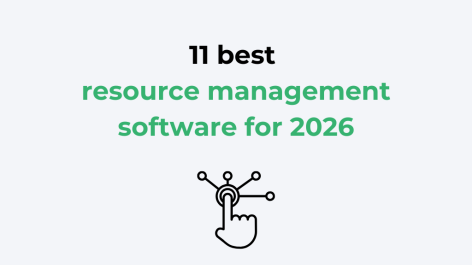In this article, we'll explore the impact of remote working on resource planning and how you can use resource management software to navigate these challenges and maximise the benefits of remote work.
How Remote Working Will Affect Your Resource Planning
Remote working has become increasingly popular in recent years, with many companies adopting this approach for its numerous benefits. One area where remote work can have a significant impact is resource planning.
The ability to tap into a larger pool of talent, collaborate with colleagues across different locations, and access lower-cost service centres are just a few examples of how remote work can transform resource planning.
However, there are also potential challenges to consider, such as time management and team motivation. In this article, we'll explore the impact of remote working on resource planning and how you can use resource management software to navigate these challenges and maximise the benefits of remote work.
Types of remote working
For context, we’ll briefly outline the three main types of remote work models:
Hybrid
This is where a portion of the workforce works from home, while the rest work from the office on a regular basis. However, this model has certain limitations since both groups may not be aligned, making it challenging to develop a shared culture.
All-remote
Second is the All-Remote model, where the company doesn’t invest in any office infrastructure, and employees are allowed to work from anywhere. While this approach is highly flexible, it requires a complete shift in mentality and culture in order to be successful.
Near-remote
This model addresses the limitations of the Hybrid-Remote model while also serving as a stepping stone towards the All-Remote model. In this model, everyone works from home but visits the office once or twice a week on a set schedule. Infrastructure expenses are reduced by decreasing office space, as the full staff does not report to the office on the same day. Moreover, the interpersonal link is maintained, ensuring collaboration and facilitating the development of a shared culture.
Positive impacts of remote work on resourcing
In this section, we’ll show you our predicted positive impacts that remote working will have on resource planning.
1. Wider pool of resources
With the rise of remote work, the geographical limitations that previously hindered professional HR teams from resourcing staff from outside their locality are no longer an issue. For example, staff in Birmingham can assist overburdened colleagues in London, and vice versa.
This means resource managers now have a larger pool of talent to select from when looking for the appropriate skills, experience, and suitability for a particular role. The removal of geographical restrictions can also be transformative for resource allocation, because issues relating to relocating staff to nearby offices or sites on short notice are no longer a concern since everyone is working remotely.
Lastly, with companies now resourcing talent from across the country, why limit the search there? In a remote working environment, HR teams can now access international expertise and take advantage of cost-effective service centres. This means your business can now recruit the best available staff for the job, but they also at an optimal rate.
2. More effective problem-sharing
Remote work facilitates better problem sharing, allowing issues to be absorbed, tackled, and resolved by a broader group. So, knowledge that was previously confined to one resource manager's head is now spread across a team of multiple people.
However, working across several managers nationwide or internationally can also bring its own set of challenges, such as planning complexities and information dispersion.
To address these issues, more complex resource plans may require dynamic solutions. Resource management software features can distribute workforce plans in real-time, ensuring that the right resources are allocated effectively. With a team collaborating on the same live data, problems can be identified early and addressed proactively.
3. Better collaboration
Remote work can also foster more focused collaboration. Studies indicate that remote employees are 20% to 25% more productive than their office counterparts due to fewer social distractions and more freedom to take breaks, leading to better overall performance, motivation, and creativity. This streamlined collaboration can result in clearer communication and a more defined workflow.
With resource management software, diaries, emails, documents, timesheets, and other critical engagement-related materials, your team can ensure that nothing essential is lost, regardless of how far apart everyone is.
4. Easier for international companies
As we said, remote work eliminates geographical limitations, making it easier to move resources between projects and tasks. For example, staff in one location can provide support to colleagues in another location to ensure projects are completed on time, allowing for greater flexibility in resource allocation, reducing the need for relocating staff or hiring new team members.
5. Fosters effective resource allocation
Remote work requires more streamlined and dynamic resource planning to ensure the right resources are allocated to the right projects at the right time. To make this easier, your company should leverage resource management software to manage your resources effectively.
Pain Points for Project Managers that Software can solve
While remote working can bring numerous benefits to resource planning, there can also be some negative impacts to consider:
1. Lack of face-to-face interaction
Remote working can lead to a lack of face-to-face interaction between team members, which can result in feelings of isolation and reduced collaboration. This can impact communication and may result in difficulties in sharing ideas or solving problems in a timely manner.
To combat this, resource management software makes it easy for different stakeholders to interact and collaborate, with tools like instant messaging and Kanban Boards. Cloud-based software makes collaboration this even easier, allowing users to access the company’s project management tools from any location in the world via a smartphone or laptop.
2. Challenges in time management
Managing a remote team can be difficult without the right tools in place. After all, remote workers need to be managed differently to ensure that they’re productive and engaged, which can be challenging for some managers.
With effective resource planning, you can assign time-based projects and deadlines to staff, to help increase accountability and productivity, even though each team member is working from somewhere else.
3. Job performance
Remote working can sometimes cause employees to feel disengaged and unmotivated to tackle tasks. With project management software features like time trackers and shared dashboards, instant messengers, and KPI reports, you can help employees feel part of the team, and keep them motivated by providing regular updates on their roles and performance, showing that you care about their work.
Roundup
There’s no doubt that remote work will affect resourcing, both positively and negatively. However, with the right strategy and resource management software in place, there’s no reason why your business can’t leverage this new trend, streamline performance and boost your bottom line.
Looking for more? Check out our complete guide to resource planning.
This comprehensive guide covers:
- Symptoms of poor resource planning (and how to cure them!)
- The formula for resource planning success
- Steps to future-proof your approach
- How a legacy system costs you money


